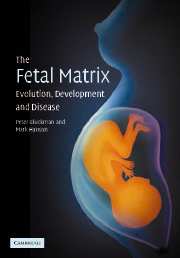Book contents
- Frontmatter
- Contents
- Preface
- 1 Shaping our destiny: genes, environment and their interactions
- 2 Mother and fetus
- 3 Fetal choices
- 4 Predictive adaptive responses and human disease
- 5 Obesity, diabetes and other diseases
- 6 The biology of predictive adaptive responses
- 7 Predictive adaptive responses – critical processes in evolution
- 8 Evolutionary echoes and the human camel
- 9 Improving human health
- 10 Fetal futures
- Further reading and references
- Index
2 - Mother and fetus
Published online by Cambridge University Press: 05 November 2011
- Frontmatter
- Contents
- Preface
- 1 Shaping our destiny: genes, environment and their interactions
- 2 Mother and fetus
- 3 Fetal choices
- 4 Predictive adaptive responses and human disease
- 5 Obesity, diabetes and other diseases
- 6 The biology of predictive adaptive responses
- 7 Predictive adaptive responses – critical processes in evolution
- 8 Evolutionary echoes and the human camel
- 9 Improving human health
- 10 Fetal futures
- Further reading and references
- Index
Summary
In the previous chapter we saw how the interaction between genes and environment might determine whether or not the individual survives under varying conditions. The leaner body shape and the longer ears of one group of rabbits aided survival in the arid regions of Australia. We introduced the concept that different phenotypes can arise from the same genotype. Towards the end of chapter 1 we started to introduce two additional concepts about such interactions – the first is that gene–environment interactions are more likely to have a major impact on phenotype if they occur early in life; the second is that an irreversible change in phenotype acting early in life can have consequences if the environment later changes. Before expanding on these concepts we need to describe the basic processes of development.
The timetable of development
The word ‘development’ means different things to different people, including scientists. To the embryologist, it implies the processes of laying down the key components of the body – the genesis of the limbs, the primitive brain and the internal organs such as the heart and gut. The genetic code for these processes, and the ways in which it can be modified by environment, are actively researched areas. To the child psychologist, however, development suggests the stages of behavioural, physical and mental attainment that human infants and children go through, namely learning to walk, to utter their first words etc.
- Type
- Chapter
- Information
- The Fetal Matrix: Evolution, Development and Disease , pp. 25 - 58Publisher: Cambridge University PressPrint publication year: 2004



